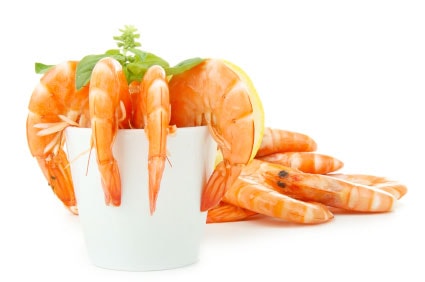
Written By: Sofia Layarda, MPH
Title: Master of Public Health
Alumni: University of California, Berkeley
Last Updated on:

This month we picked shrimp, which happens to be the second-most popular seafood choice after canned tuna. Shrimp can either be wild-caught or farmed and come in many different types and sizes. The larger sizes typically come from warmer waters, while the smaller shrimp species that prevail in colder waters tend to be more succulent.
Table of Contents
A 4-oz serving of boiled shrimp (approximately 12 or 13 large) contains:

Shrimp is a great low-fat source of protein, but has sometimes been unfairly dismissed because of its high level of naturally occurring cholesterol. (While shrimp does in fact contain cholesterol, the level of saturated fats and trans fats in the foods you eat have a greater bearing on your blood cholesterol profile.) Shrimp is high in omega-3 fatty acids, which have been shown to benefit both your brain and your cardiovascular system. Shrimp is also extremely high in selenium, a micronutrient that plays a big role in antioxidant enzymes within the body, as well as shutting down pathways that lead to cancer. Selenium has also been shown to inhibit cancer cells while helping DNA repair in damaged cells. To top it off, shrimp is also a good source of iron, Vitamin B12, and Vitamin D.
As with any seafood, fresh raw shrimp is extremely fragile and should be purchased as close to consumption time as possible. Buy from stores with an established reputation for a fresh supply of seafood. Fresh raw shrimp should smell like saltwater, with no ammonia “off” smell. The body of the shrimp should feel firm, not mushy, and should be firmly attached to the shell.
If you have to store raw shrimp in the fridge, pack the wrapped shrimp in a container with ice and water, put it in the deepest, lowest corner of the fridge and consume within 24 hours. Frozen shrimp lasts longer but should be used within a few months. Cooked leftovers can be refrigerated but should be eaten within 2 days.
Alumni: University of California, Berkeley – Sofia believes in bringing back fun and pleasure into everyday eating. She loves cooking, and is constantly experimenting with ingredients, creating recipes and trying them out on family and friends. Her latest interest lies in finding realistic and practical ways of environmentally-friendly food/eating habits.
grocery aisle, healthy every month, prawns, seafood, shrimp
Surprising Ways the Office Candy Dish May be Sabotaging Your Diet
What Does a Serving Look Like? Serving Size 101: Visual Reference Guide